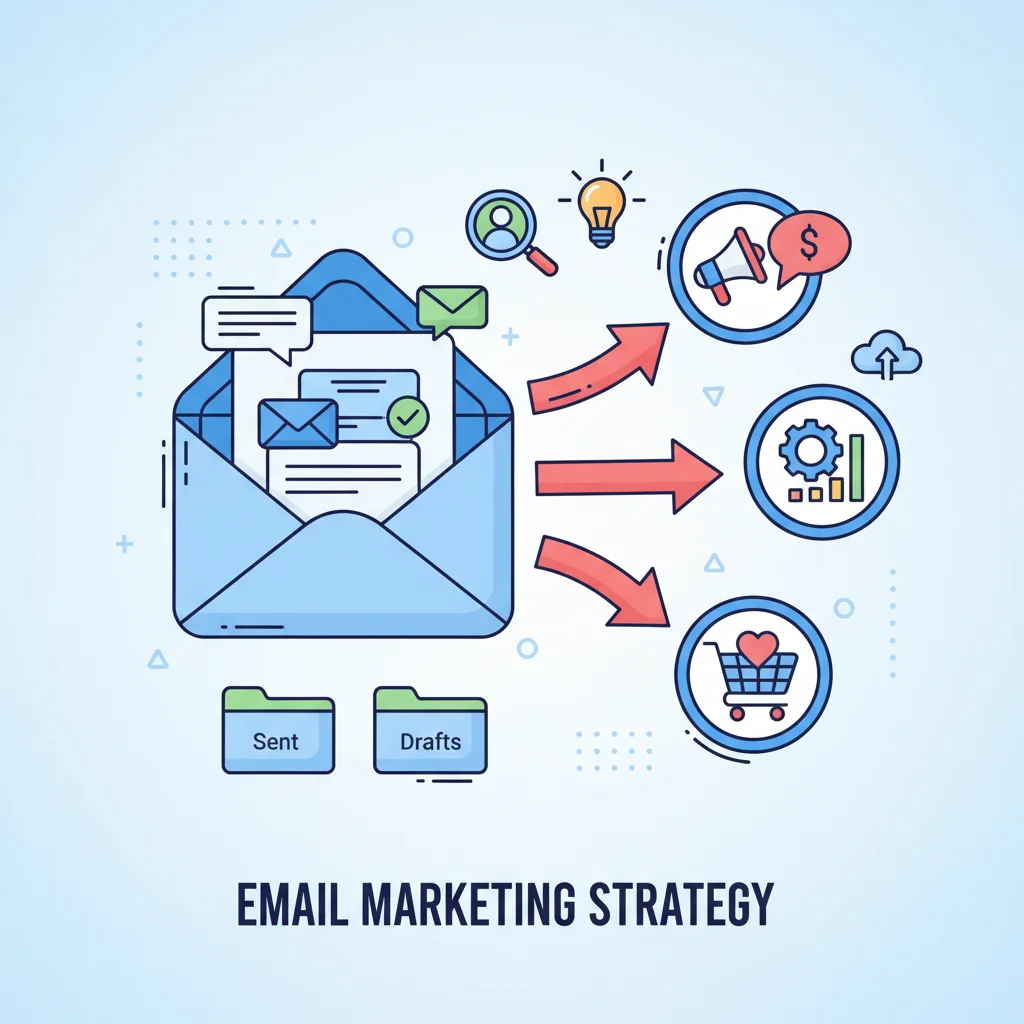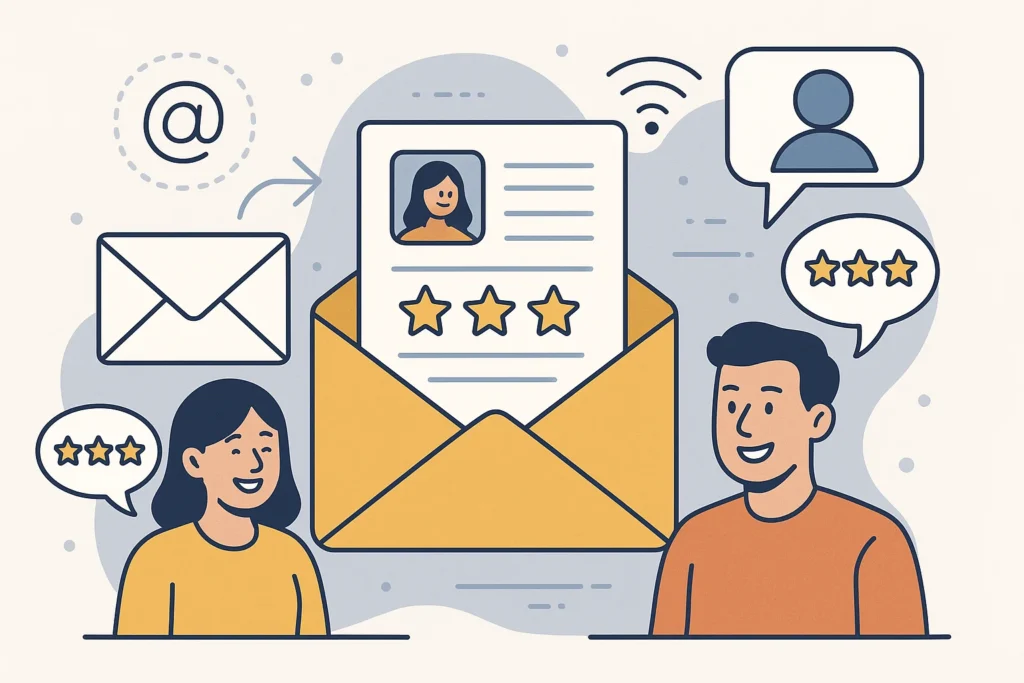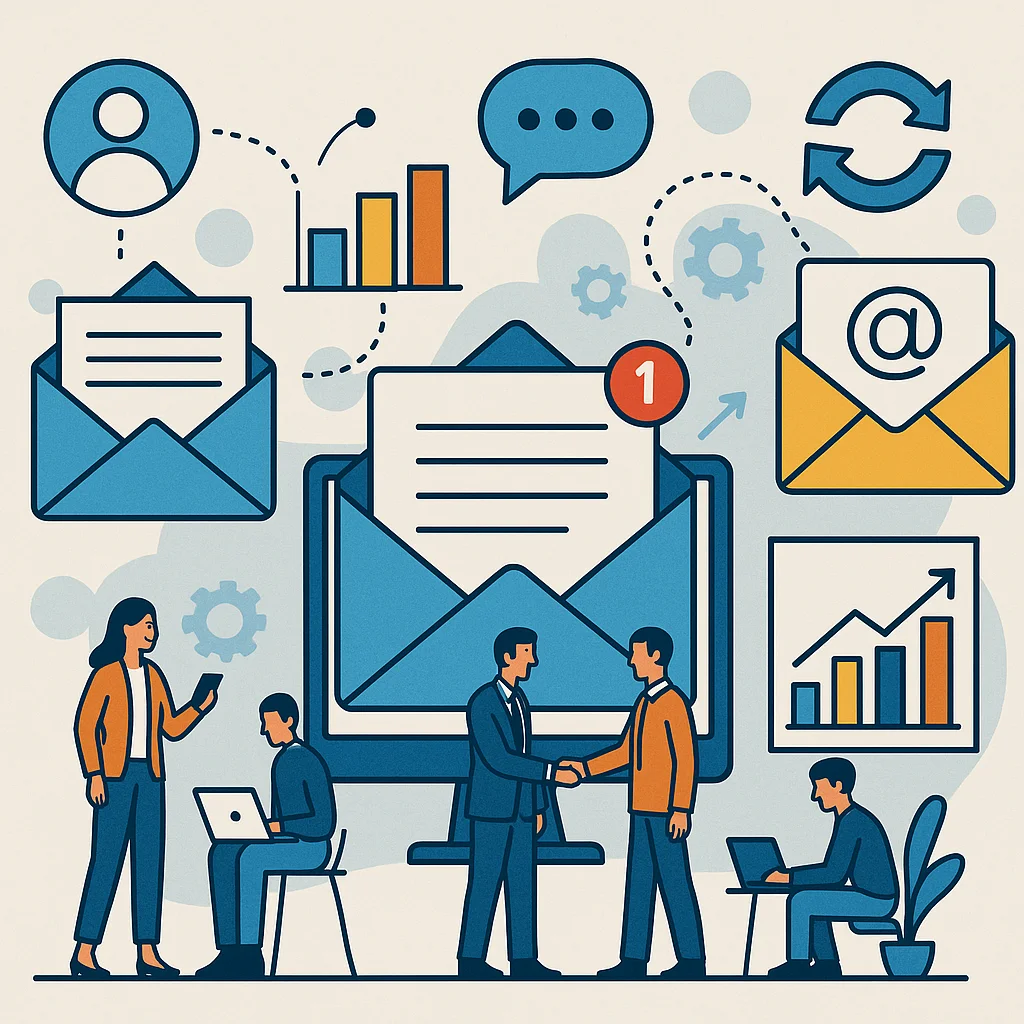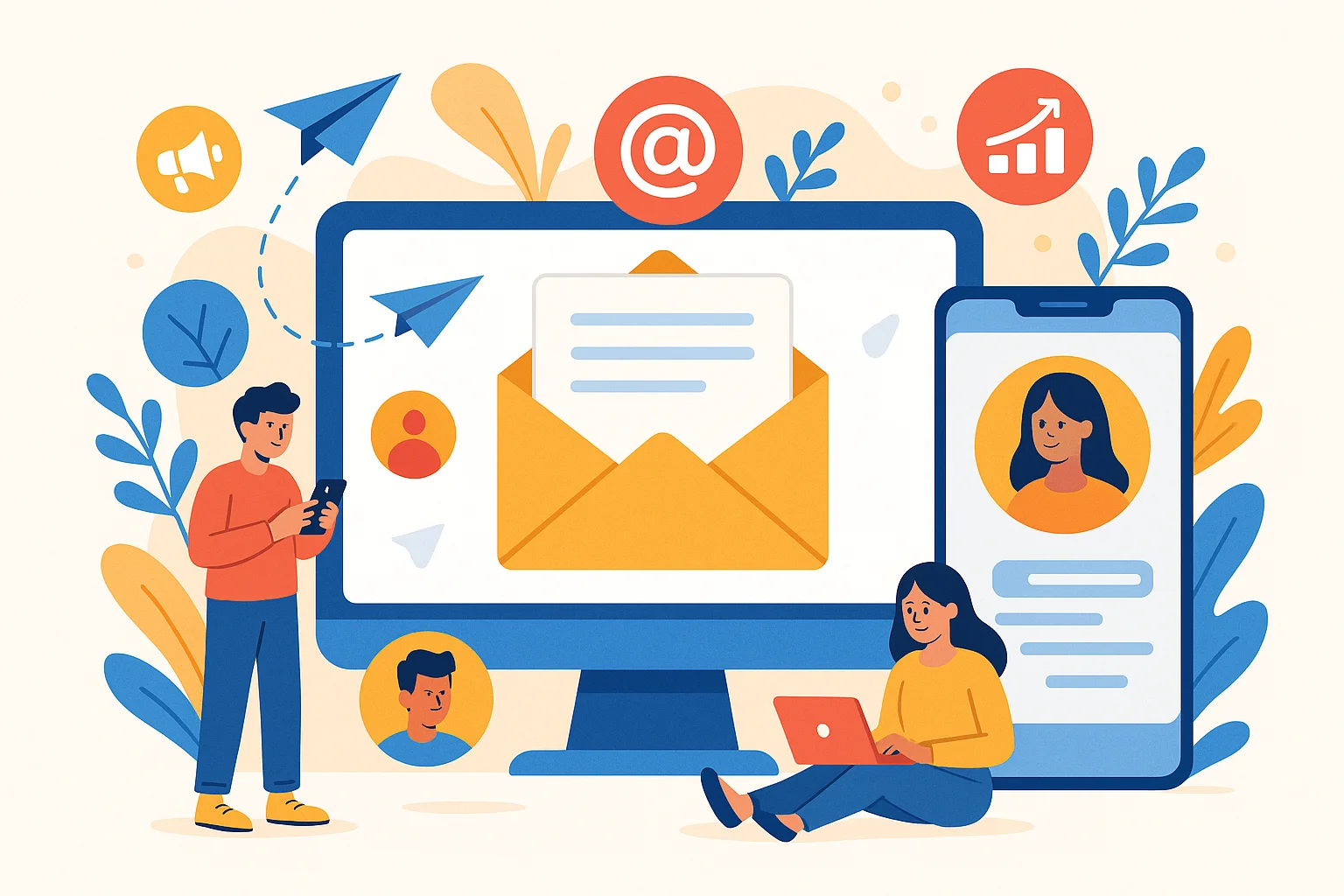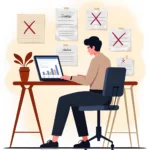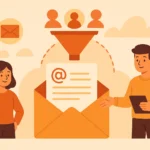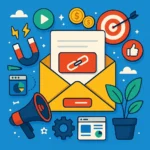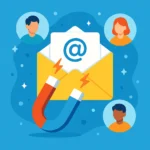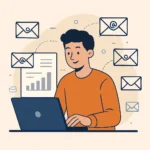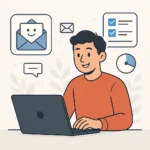Now Reading: 15 Best Email Marketing Strategies For B2B
-
01
15 Best Email Marketing Strategies For B2B
15 Best Email Marketing Strategies For B2B
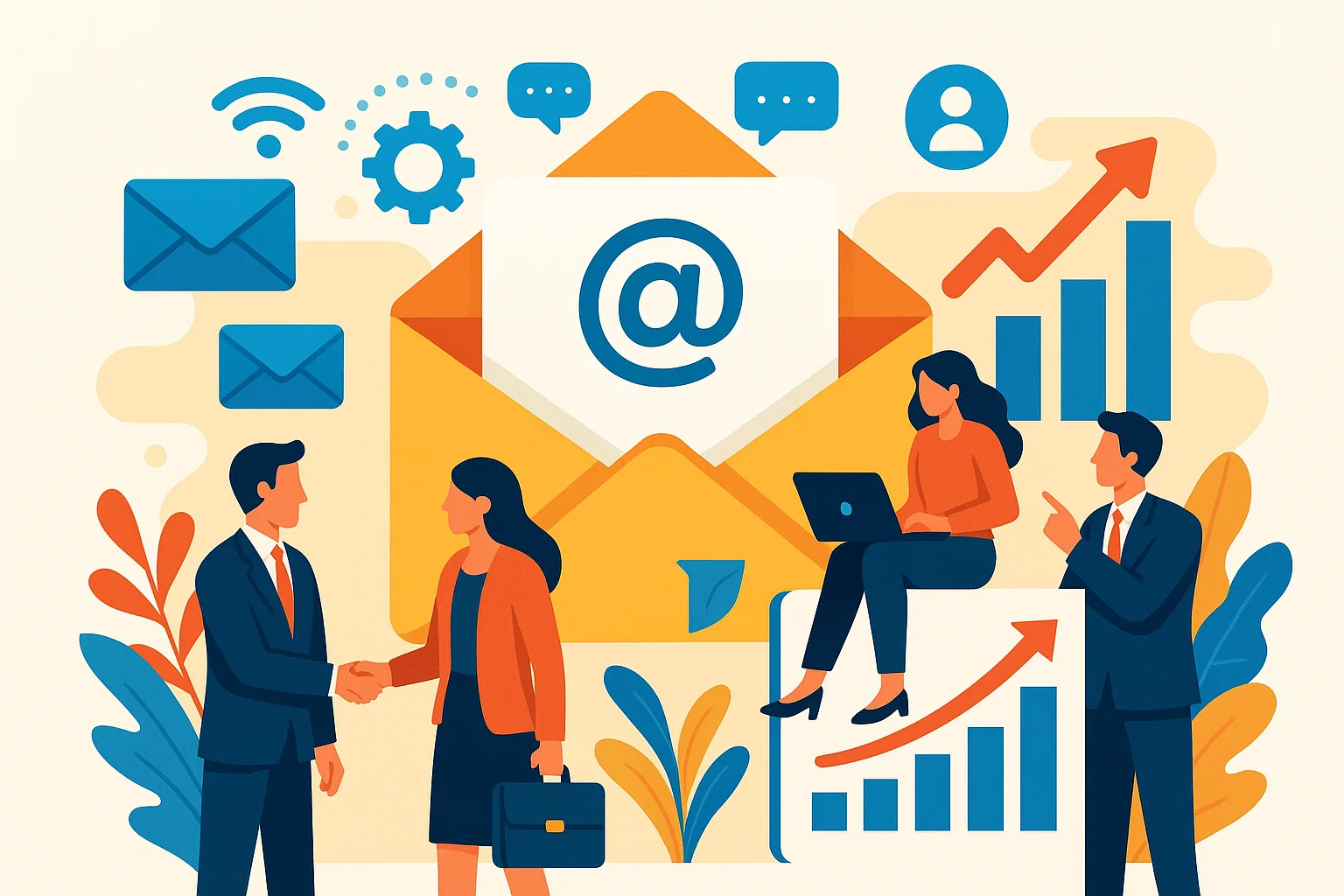
Forget everything you think you know about B2B email marketing. Those “best practices” you’ve been following? Many of them are outdated myths that are actively hurting your results. No, you don’t need to send emails at exactly 10:32 AM on Tuesdays. No, your subject lines don’t need to be under 40 characters. And no, you absolutely shouldn’t “follow up just to touch base.” The truly best email marketing strategies for B2B cut through the conventional wisdom and focus on what actually works based on data, not opinions. I’m about to challenge some sacred cows and give you 15 strategies that might contradict what you’ve heard – but will deliver results you can measure.
Key Takeaways
What are the best email marketing strategies for B2B companies? Here are the 15 best email marketing strategies for B2B:
- Segment your email list based on industry, behavior, and buying stage
- Personalize beyond just using first names in subject lines
- Craft compelling subject lines that spark curiosity or highlight value
- Focus on solving problems rather than promoting features
- Implement automated email sequences for lead nurturing
- Use storytelling to create emotional connections with prospects
- Optimize emails for mobile viewing experience
- Include clear, benefit-focused calls-to-action
- Test different email elements systematically (A/B testing)
- Clean your email list regularly to maintain deliverability
- Time your sends based on recipient behavior, not generic “best times”
- Integrate email campaigns with your overall content strategy
- Use social proof and testimonials to build credibility
- Create interactive email experiences with polls or clickable elements
- Analyze and iterate based on performance metrics
Segment Your Email List Based On Industry, Behavior, And Buying Stage
Let’s be real – blasting the same generic email to your entire database is about as effective as shouting into the void. One of the best email marketing strategies for B2B is segmentation, and it’s non-negotiable if you want results.
When you segment your list, you’re essentially saying, “I see you as an individual with specific needs” rather than “You’re just another email address to me.” And guess what? People respond to that personalized approach.
Here’s how to segment effectively:
Industry-Based Segmentation
Different industries have different pain points. A manufacturing company has completely different challenges than a healthcare provider. By segmenting by industry, you can:
- Reference industry-specific challenges they’ll instantly recognize
- Use terminology that resonates with their daily experience
- Showcase case studies from similar companies
For example, an email to manufacturing prospects might focus on efficiency and cost reduction, while one to healthcare might emphasize compliance and patient outcomes.
Behavior-Based Segmentation
This is where things get really powerful. Track how contacts interact with your previous emails and website, then segment based on:
- Content they’ve engaged with (which indicates their interests)
- Frequency of engagement (which signals their level of interest)
- Specific actions taken (like downloading certain resources)
Someone who’s repeatedly viewed your pricing page deserves a different email than someone who’s only ever read your educational blog posts.
Buying Stage Segmentation
Not everyone is ready to buy right now. By segmenting based on where prospects are in their journey, you can deliver the right message at the right time:
- Awareness stage: Educational content that helps them understand their problem
- Consideration stage: Solution-focused content that positions your offering
- Decision stage: Conversion-focused content with clear next steps
The data backs this up: segmented email campaigns drive a 760% increase in revenue compared to one-size-fits-all campaigns. That’s not a typo – 760%!
Don’t overcomplicate this. Start with 3-5 segments and expand as you gather more data. Even basic segmentation beats no segmentation every time.
Personalize Beyond Just Using First Names In Subject Lines
We’ve all received those emails: “Hey [FIRST NAME], check out our amazing offer!” Yawn. That’s not personalization – that’s the bare minimum. And in B2B, where relationships and relevance rule, you need to go deeper.
True personalization means tailoring the entire email experience to the recipient’s specific context. When done right, personalized emails deliver 6x higher transaction rates. But how do you go beyond the basics?
Personalize Based On Company Information
Use what you know about their organization to make your email instantly relevant:
- Reference their company size (“perfect for mid-sized manufacturing firms like yours”)
- Mention recent company news (“Congrats on your recent expansion into the European market”)
- Acknowledge their tech stack (“Since you’re using Salesforce, you’ll appreciate how our solution…”)
This shows you’ve done your homework and aren’t just sending random emails.
Personalize Based On Role And Responsibilities
Different stakeholders care about different things:
- For C-suite: Focus on strategic impact and ROI
- For managers: Emphasize efficiency and team productivity
- For users: Highlight ease of use and specific features
I recently sent an email campaign where we created three versions of the same announcement – one for each decision-maker level. The executive version had 3x the engagement of our previous generic approach.
Personalize The Content Recommendations
If someone downloaded your whitepaper on supply chain optimization, your follow-up email should recommend related content – not your general newsletter.
This might sound like a lot of work, but modern email marketing platforms make this easier than you think. You can set up dynamic content blocks that change based on recipient attributes or behaviors.
A word of caution: don’t get creepy. There’s a fine line between “they understand my needs” and “how do they know that about me?” Stick to information they’ve willingly shared or that’s publicly available.
The effort is worth it. According to research, 72% of consumers only engage with personalized messaging. In B2B, where purchase decisions are higher-stakes, this percentage is likely even higher.
Useful Articles:
Craft Compelling Subject Lines That Spark Curiosity Or Highlight Value
Let’s face it – if your subject line flops, nothing else matters. Your brilliant email will never see the light of day. Subject lines are the gatekeepers to your content, and in B2B email marketing, they need special attention.
The average professional receives 121 emails daily. Your subject line has to fight through that noise and earn the click. Here’s how to craft subject lines that actually work:
Spark Curiosity (Without Clickbait)
Curiosity is a powerful motivator. Create an information gap that can only be filled by opening your email:
- “The strategy most [industry] companies overlook”
- “What we discovered analyzing 1,000+ B2B campaigns”
- “3 questions your competitors hope you never ask”
The key is delivering on the promise. Clickbait might get opens once, but it destroys trust.
Highlight Specific Value
B2B decision-makers are busy and pragmatic. Tell them exactly what they’ll gain:
- “Cut implementation time by 50% with this approach”
- “The 5-minute fix for your [specific problem]”
- “New data: How top performers handle [common challenge]”
Notice how these are specific and quantified where possible. Vague benefits don’t compel action.
Use Social Proof In Subject Lines
Leverage the credibility of others:
- “How [well-known company] increased conversions by 37%”
- “Join 250+ [industry] leaders using this strategy”
- “[Respected person] shares their [topic] playbook”
This taps into both curiosity and FOMO (fear of missing out).
Keep It Conversational And Human
B2B doesn’t have to mean boring. Some of my best-performing subject lines have been surprisingly casual:
- “Quick question about your [specific process]”
- “Thoughts on this approach to [common challenge]?”
- “Did you see this? Might solve your [problem]”
These work because they feel like they’re from a real person, not a marketing department.
I’ve found that subject lines between 4-7 words often perform best. They’re long enough to convey value but short enough to be fully visible on mobile devices (where 60% of emails are now opened).
Test everything. What works for one audience might bomb with another. I once had two nearly identical campaigns where the winning subject line for audience A performed terribly with audience B. There’s no substitute for testing with your specific audience.
Focus On Solving Problems Rather Than Promoting Features
One of the biggest mistakes in B2B email marketing? Droning on about your amazing features while your reader’s eyes glaze over. Nobody – and I mean nobody – wakes up excited to read about your “robust integration capabilities” or “scalable infrastructure.”
What they do care about? Their problems. Their challenges. Their sleepless nights. When you focus on solving these, you transform from annoying vendor to valuable partner.
Identify The Real Pain Points
Before writing a single email, ask yourself:
- What keeps my prospect up at night?
- What’s the cost of their current situation?
- What’s preventing them from reaching their goals?
For example, a CRM company shouldn’t lead with “our platform has 50+ integrations.” Instead, try “Stop losing deals because your sales data lives in 7 different systems.”
Frame Features As Solutions
Features still matter – but only in the context of how they solve problems:
Instead of: “Our platform includes real-time analytics”
Try: “Never be blindsided in a client meeting again”
Instead of: “24/7 customer support”
Try: “Get unstuck and back to work in minutes, any time of day”
This subtle shift makes your email instantly more relevant and compelling.
Use The “So What?” Test
For every statement in your email, ask “so what?” until you get to the real benefit.
“Our platform automates reporting.”
So what?
“It saves 5 hours of manual work each week.”
So what?
“Your team can focus on strategy instead of spreadsheets.”
So what?
“You’ll identify new opportunities faster than competitors.”
That final benefit is what belongs in your email – not the feature itself.
Speak To Emotional And Rational Needs
Even in B2B, decisions have emotional components. Address both:
Rational: “Reduce implementation time by 40%”
Emotional: “Earn recognition as the innovator who transformed your department”
I once rewrote a client’s entire email sequence to focus on problem-solving instead of feature promotion. Open rates stayed roughly the same, but click-through rates jumped 58% and conversions more than doubled. People engage with solutions, not specifications.
Implement Automated Email Sequences For Lead Nurturing
Let’s be honest – most B2B purchases don’t happen after a single email. The typical B2B buying journey involves 6-10 decision-makers and takes months to complete. This is where automated email sequences become your secret weapon.
Instead of hoping prospects remember you between sporadic campaigns, you can stay top-of-mind with strategic, timely messages that move them through their buying journey.
Map Sequences To The Buyer’s Journey
Different stages require different approaches:
Awareness Stage Sequence
- Email 1: Introduce the problem and its implications
- Email 2: Share educational content about solving the problem
- Email 3: Present different approaches to the solution
- Email 4: Soft introduction to your approach
Consideration Stage Sequence
- Email 1: Deep dive into your methodology
- Email 2: Case study showing results
- Email 3: Comparison of approaches (positioning yours favorably)
- Email 4: Address common objections
Decision Stage Sequence
- Email 1: Specific offer with clear next steps
- Email 2: Social proof from similar companies
- Email 3: Address final objections
- Email 4: Last chance with incentive
Trigger Sequences Based On Behavior
The most effective sequences respond to prospect actions:
- Website visits to specific pages
- Content downloads
- Webinar registrations or attendance
- Product demo requests
For example, when someone downloads your industry report, trigger a 4-email sequence that builds on that initial interest rather than sending unrelated messages.
Include Strategic Pauses And Accelerations
Not all prospects move at the same pace. Build in logic that:
- Accelerates the sequence when prospects show high engagement
- Slows down or pauses when engagement drops
- Moves prospects to different sequences based on their actions
I worked with a SaaS company that implemented this approach and saw their lead-to-opportunity conversion rate increase by 23% in just two months. The key was delivering the right content at the right time, rather than overwhelming prospects with everything at once.
Make Each Email Stand Alone
Even in a sequence, each email should make sense independently. Some recipients will miss emails or join mid-sequence. Each message should deliver value on its own while still fitting into the larger narrative.
Automation doesn’t mean “set it and forget it.” Review performance regularly and refine your sequences. The best sequences evolve based on data and changing market conditions.
Use Storytelling To Create Emotional Connections With Prospects
In a world of feature lists and bullet points, storytelling cuts through the noise. Our brains are literally wired for stories – they activate more parts of our brain than plain facts and help us remember information better.
For B2B email marketing, storytelling isn’t fluff – it’s a strategic advantage that creates emotional connections with prospects.
Structure Emails As Mini-Stories
Even a short email can follow a basic story structure:
- Setup: Establish the situation and challenge
- Conflict: Highlight what’s at stake
- Resolution: Show how the problem was solved
For example:
“When [Company X] came to us, they were losing 20% of their leads due to slow follow-up times. Their sales team was drowning in manual tasks, and competitors were scooping up their prospects. After implementing our automation solution, their response time dropped from 12 hours to 10 minutes, and their conversion rate increased by 35%.”
This simple structure is infinitely more compelling than “Our solution reduces response times and increases conversions.”
Use Customer Success Stories
Real stories from real customers are storytelling gold. They provide:
- Authenticity that you can’t fake
- Relatable situations for prospects
- Proof that your solution works
I’ve found that emails featuring customer stories consistently outperform product-focused emails by 20-30% in terms of engagement.
Make Your Prospect The Hero
The most effective B2B stories position your prospect – not your company – as the hero:
- Your prospect is the protagonist facing challenges
- Your solution is the tool that helps them succeed
- The outcome is their victory, not yours
This subtle shift makes your email about them, not you.
Use Concrete Details And Specifics
Vague stories don’t resonate. Include specific details:
- Actual numbers and percentages
- Time frames
- Named individuals (with permission)
- Specific challenges and solutions
“A customer improved their process” is forgettable. “Sarah at Acme Corp reduced manual reporting time from 12 hours to 30 minutes within the first week” sticks with you.
Connect Stories To Broader Themes
The best B2B stories connect individual experiences to universal challenges in your industry. This helps prospects see themselves in the story even if the details differ from their situation.
I once worked with a client who replaced all their feature-focused emails with story-based ones. Not only did engagement increase, but sales reported that prospects were coming to calls already talking about the stories they’d read – the ultimate sign that the messages had resonated.
Optimize Emails For Mobile Viewing Experience
Let’s get real: 61% of all emails are now opened on mobile devices, and for busy B2B decision-makers, that percentage is likely even higher. If your emails look terrible on mobile, you’re essentially throwing away more than half your potential engagement.
Yet I’m constantly amazed at how many B2B emails still arrive with tiny text, broken layouts, and CTAs that require microscopic precision to tap. Here’s how to avoid these mobile disasters:
Embrace Single-Column Layouts
Multi-column designs might look great on desktop but turn into an unreadable mess on mobile. Stick to a single column that flows naturally on any screen size.
I’ve tested this extensively, and single-column emails consistently outperform complex layouts in both open and click-through rates on mobile devices.
Make Text Readable Without Zooming
Nothing kills engagement faster than forcing readers to pinch and zoom. Use:
- Minimum 14px font size for body text
- 22px+ for headlines
- High contrast between text and background
- Short paragraphs (2-3 sentences max)
Design Tap-Friendly CTAs
Your brilliant email is pointless if people can’t tap your call-to-action. Make CTAs:
- At least 44×44 pixels (Apple’s recommended minimum tap size)
- Surrounded by enough white space to prevent accidental taps
- Visually distinct from surrounding content
- Positioned where they won’t be missed (often mid-email works better than bottom)
Keep File Sizes Small
Mobile users may be on limited data plans or spotty connections. Large images that take forever to load will tank your engagement. Optimize all images and keep the total email size under 100KB when possible.
Preview Text Matters More On Mobile
On many mobile email clients, the preview text (the snippet shown after the subject line) takes up significant screen real estate. Make it count by:
- Avoiding wasted phrases like “View in browser” or “Having trouble viewing?”
- Using it as a secondary headline that complements your subject line
- Including a benefit or teaser that encourages opening
Test On Actual Devices
Email testing tools are great, but nothing beats checking your emails on actual smartphones and tablets. Different devices and email apps render content differently.
I once sent an email that looked perfect in testing tools but had a completely broken CTA on Samsung devices – which represented about 30% of our mobile audience. Now I always check on at least 3-4 different physical devices before sending.
Remember: mobile optimization isn’t just about avoiding disasters – it’s about creating an experience that feels natural and effortless on a small screen. When done right, your mobile-optimized emails might even outperform their desktop counterparts.
Useful Articles:
Include Clear, Benefit-Focused Calls-To-Action
Let’s talk about one of the most underrated elements of successful B2B email marketing: the humble call-to-action (CTA). I’ve seen countless emails with brilliant copy and compelling offers fall flat because they ended with a wimpy “Click here” or – even worse – multiple competing CTAs that confused readers into doing nothing.
Your CTA is where all the magic happens. It’s the bridge between interest and action. Here’s how to nail it:
One Primary CTA Per Email
The single biggest CTA mistake? Including too many. When you ask for multiple actions, you often get none. Research shows that emails with a single CTA increased clicks by 371% compared to those with multiple CTAs.
If you absolutely must include secondary options, make them visually subordinate to your primary CTA.
Focus On Benefits, Not Actions
Compare these two CTAs:
“Download Whitepaper” vs. “Get Your Cost-Cutting Guide”
“Schedule Demo” vs. “See How Much Time You’ll Save”
“Learn More” vs. “Discover Your Automation Potential”
The second options in each pair focus on what the prospect gets, not what they have to do. This subtle shift can dramatically improve click-through rates.
Use First-Person Language
A fascinating study found that changing button text from “Start your free trial” to “Start my free trial” increased clicks by 90%. First-person language helps prospects envision themselves taking action.
Create Urgency (When Authentic)
Adding genuine urgency can boost conversion:
“Secure your spot (only 5 left)”
“Get access before the price increase”
“Join 50 others who registered today”
The key word is genuine – fake urgency damages trust.
Position Strategically
Don’t automatically stick your CTA at the bottom of your email. Consider:
- After the most compelling benefit
- Following a powerful testimonial
- Immediately after addressing a key objection
I’ve found that mid-email CTAs often outperform those at the very end, especially in longer emails.
Make It Visually Distinct
Your CTA should stand out visually:
- Use a button rather than a text link for primary CTAs
- Choose a contrasting color that pops
- Surround it with white space
- Make it large enough to be easily clickable (especially on mobile)
Test, Test, Test
CTAs are perfect for A/B testing because:
- They’re simple to change
- The impact is directly measurable
- Small tweaks can yield big results
I once increased a client’s click-through rate by 37% just by changing their CTA from “Request Information” to “Get My Custom Analysis.” Same destination, dramatically different results.
Remember: your CTA isn’t just a button or link – it’s the culmination of everything your email has been building toward. Give it the attention it deserves.
Test Different Email Elements Systematically (A/B Testing)
Guessing what will work in your B2B email marketing is like throwing darts blindfolded. You might occasionally hit the target, but you’ll miss a lot more often than you hit. A/B testing removes the blindfold and gives you data-driven clarity.
But let me be straight with you – random testing without a system is almost as bad as no testing at all. Here’s how to approach A/B testing strategically:
Test One Element At A Time
The cardinal rule of A/B testing: change only one variable per test. If you change multiple elements, you won’t know which one made the difference.
Focus on testing these high-impact elements:
- Subject lines (often the biggest needle-mover)
- Preview text
- CTA wording and design
- Email layout and format
- Personalization approaches
- Content length and style
Prioritize Tests By Potential Impact
Not all tests are created equal. Prioritize based on:
- Elements that affect whether emails get opened (subject lines, sender name)
- Elements that affect whether people take action (CTAs, offers)
- Elements that affect the overall experience (design, copy length)
I once wasted weeks testing minor design elements when a simple subject line test would have yielded much greater results.
Ensure Statistical Significance
Small sample sizes can lead to misleading results. As a rule of thumb:
- For open rate tests: minimum 1,000 recipients per variant
- For click-through tests: minimum 100 opens per variant
Most email platforms will tell you when a result is statistically significant.
Document And Build On Learnings
Create a testing log that records:
- What you tested
- Your hypothesis
- The results
- Insights gained
- Next steps
This prevents you from repeating tests and helps you build a knowledge base of what works for your specific audience.
Test Across Different Segments
What works for one segment might fail with another. I’ve seen subject lines that performed brilliantly with C-suite prospects completely flop with technical buyers.
Run parallel tests across different audience segments to develop segment-specific insights.
Move Beyond Open And Click Rates
While these metrics matter, also track:
- Conversion rates on landing pages
- Time spent on page after click
- Pipeline influence
- Revenue attribution
A variant might get fewer clicks but higher quality ones that actually convert.
I worked with a company that discovered their text-only emails got 15% fewer opens than their beautifully designed HTML emails – but generated 40% more qualified opportunities. Without testing all the way through the funnel, they would have made the wrong choice.
Remember: A/B testing isn’t a one-and-done activity. It’s an ongoing process of incremental improvement that compounds over time.
Clean Your Email List Regularly To Maintain Deliverability
Let’s talk about something unsexy but absolutely critical: email list hygiene. A bloated, outdated list isn’t just ineffective – it’s actively harmful to your email marketing success.
Think of it this way: would you rather have 50,000 email addresses with a 5% engagement rate or 10,000 addresses with a 30% engagement rate? The math is clear – the smaller, engaged list will drive more results every time.
Here’s why list cleaning matters and how to do it right:
The Hidden Costs Of A Dirty List
A list full of unengaged contacts creates multiple problems:
- Lower deliverability rates (ISPs notice when people don’t open your emails)
- Skewed metrics that mask your true performance
- Higher costs with most email service providers
- Increased risk of being marked as spam
I’ve seen companies improve their deliverability by 15-20% just by removing inactive subscribers.
Implement A Sunset Policy
Create clear rules for when to remove contacts:
- No opens in 3-6 months (for regular sends)
- No opens in 4-8 emails (regardless of timeframe)
- Hard bounces (remove immediately)
- Soft bounces (remove after 3 consecutive)
Document this policy and stick to it, even when the numbers look temporarily painful.
Try A Re-Engagement Campaign First
Before removing unengaged contacts, give them one last chance:
- Send a “We miss you” email with a compelling offer
- Be direct about your intentions (“We’re cleaning our list…”)
- Make it easy to stay subscribed
- Remove those who don’t respond
These campaigns typically get 3-5% of inactive subscribers to re-engage – not huge, but worth the effort for valuable contacts.
Use Double Opt-In For New Subscribers
Prevent list problems before they start by using double opt-in:
- Person submits their email
- They receive a confirmation email
- They must click to confirm subscription
This extra step reduces fake emails, typos, and uninterested subscribers from ever joining your list.
Monitor Engagement Metrics Closely
Keep an eye on these key deliverability indicators:
- Open rate trends over time
- Spam complaint rate (should be under 0.1%)
- Bounce rate (should be under 2%)
- Unsubscribe rate (normal is 0.2-0.5% per send)
Declining metrics often signal list quality issues.
I worked with a B2B tech company that was afraid to clean their list because they’d “worked so hard to build it.” After much convincing, they removed 60% of their unengaged contacts. Their next campaign had triple the engagement rate and generated more leads than their previous three campaigns combined.
Remember: email marketing success isn’t about list size – it’s about list quality. A smaller, more engaged list will outperform a bloated one every time.
Time Your Sends Based On Recipient Behavior, Not Generic “Best Times”
You’ve probably seen those articles claiming “Tuesday at 10 AM is the best time to send B2B emails!” I’m here to tell you – that’s complete nonsense. There is no universal “best time” that works for all audiences.
What works for one industry, company size, or job function might be terrible for another. The key is to time your sends based on your specific recipients’ actual behaviors, not generic best practices.
Track Individual Engagement Patterns
Modern email platforms can track when individual recipients typically open emails. Use this data to:
- Send to each contact at their personal optimal time
- Group similar contacts into time-based segments
- Identify patterns specific to your audience
I’ve seen open rates increase by 23% simply by switching from a generic send time to individualized timing.
Consider Time Zone Differences
For global audiences, sending at 9 AM in every recipient’s local time zone can dramatically improve performance. Most email platforms now offer time zone sending features.
For one client with a global audience, implementing time zone-based sending increased their overall open rate by 11% overnight.
Account For Device Usage Patterns
When people check email varies by device:
- Desktop: During business hours (peaks mid-morning and after lunch)
- Mobile: Throughout the day, with spikes during commute times and evenings
If your analytics show high mobile usage, consider testing sends outside traditional business hours.
Day Of Week Matters More Than Time Of Day
For many B2B audiences, the day you send can have more impact than the specific hour:
- Monday: Inboxes are often crowded after the weekend
- Friday: Decision-making energy is typically lower
- Midweek: Often provides the best balance
But again – test this with your specific audience rather than following generic advice.
Align With Your Sales Team’s Rhythm
If your emails are part of a sales process, coordinate timing with your sales team’s follow-up capacity:
- Don’t send important emails when sales can’t follow up promptly
- Consider your sales team’s time zone and working hours
- Avoid sending right before weekends or holidays
Use Behavioral Triggers Instead Of Calendar Timing
The most effective timing isn’t about the clock – it’s about responding to prospect actions:
- Website visits
- Content downloads
- Product usage (for existing customers)
- Previous email engagement
An email triggered by a prospect’s behavior will almost always outperform one sent on an arbitrary schedule.
I once worked with a company that switched from weekly batch sends to behavior-triggered emails. Their click-to-meeting conversion rate increased by 67%, even though they were sending fewer total emails.
The bottom line: forget the generic “best time to send” advice. Use your data to understand when your specific audience is most receptive, and you’ll see dramatically better results.
Integrate Email Campaigns With Your Overall Content Strategy
Email doesn’t exist in a vacuum. When your email marketing operates as an isolated channel, you miss enormous opportunities for synergy with your broader content strategy.
The most successful B2B companies view email as part of an integrated content ecosystem, where each piece reinforces and amplifies the others. Here’s how to make that happen:
Map Content To The Buyer’s Journey
Create a content matrix that aligns all content – including emails – to specific stages:
- Awareness: Educational blog posts, industry reports, trend analyses
- Consideration: Comparison guides, case studies, webinars
- Decision: Product demos, ROI calculators, implementation guides
Your emails should strategically guide prospects through this journey, connecting the right content at the right time.
Repurpose Content Across Channels
Don’t create email content from scratch when you can leverage existing assets:
- Turn blog post series into nurture email sequences
- Extract key points from webinars for follow-up emails
- Transform case studies into customer story emails
- Use social media feedback to inform email topics
This approach ensures message consistency while saving significant time and resources.
Use Email To Amplify Other Content Investments
Email is the perfect distribution channel for your content:
- Promote new blog posts to relevant segments
- Drive registration for upcoming webinars
- Distribute research reports to specific industries
- Share video content with prospects who prefer that format
I’ve seen companies increase content ROI by 3-4x simply by implementing strategic email distribution.
Create Email-Exclusive Content
While repurposing is efficient, also create some email-only content to reward subscribers:
- Early access to new research
- Subscriber-only resources
- Exclusive interviews or insights
- Special offers not available elsewhere
This gives people a reason to stay subscribed and engaged with your emails.
Maintain Consistent Messaging And Voice
Nothing confuses prospects more than inconsistent messaging. Ensure your emails use the same:
- Value propositions as your website
- Terminology as your sales team
- Voice and tone as your other content
- Visual identity as your brand guidelines
This consistency builds trust and reinforces your key messages across all touchpoints.
One of my clients struggled with disconnected content – their blog said one thing, sales said another, and emails contained yet another message. By creating a unified content strategy with email as a core component, they increased marketing-sourced opportunities by 34% in one quarter.
Remember: the goal isn’t just to send good emails – it’s to create a cohesive experience where email strengthens your overall marketing approach and vice versa.
Useful Articles:
Use Social Proof And Testimonials To Build Credibility
In B2B decision-making, risk aversion is a powerful force. No one wants to be the person who championed a failed solution. That’s why social proof is so incredibly effective in B2B email marketing – it reduces perceived risk by showing that others have already taken the leap and succeeded.
When strategically incorporated into your emails, social proof can dramatically increase trust and conversion rates. Here’s how to do it right:
Feature Relevant Testimonials
The key word is relevant. A testimonial from a company nothing like your prospect’s won’t resonate. Instead:
- Match testimonials to the recipient’s industry
- Feature companies of similar size when possible
- Highlight similar challenges and outcomes
- Use testimonials from the same role as your recipient
For example, send CFOs testimonials from other financial executives, not from IT managers.
Include Specific Results
Vague praise is forgettable. Specific results are compelling:
Weak: “Great product, we love it!”
Strong: “We reduced customer onboarding time from 2 weeks to 3 days and increased retention by 22% in the first quarter.”
The more specific and measurable the outcome, the more powerful the testimonial.
Incorporate Various Forms Of Social Proof
Testimonials are just one type of social proof. Also consider:
- Case studies (summarized in email, with link to full version)
- Usage statistics (“Trusted by 10,000+ companies”)
- Industry awards and recognition
- Third-party reviews and ratings
- Client logos (when permission is granted)
Different types of social proof work better at different stages of the buyer’s journey.
Position Social Proof Strategically
Where you place social proof matters:
- After introducing a key benefit (to validate it)
- Near your call-to-action (to reduce last-minute hesitation)
- Following potential objections (to overcome them)
I’ve found that placing a strong testimonial immediately before your CTA can increase click-through rates by 15-20%.
Make It Visually Stand Out
Don’t bury testimonials in your regular text. Use design elements to make them pop:
- Different background color
- Quotation marks or icons
- The person’s photo (increases credibility)
- Company logo when appropriate
Visual distinction signals to skimmers that this is important third-party validation, not just your marketing claims.
One of my clients was struggling with low demo request rates from their email campaigns. We added a carousel of three industry-specific testimonials to their emails, each with concrete results. Demo requests increased by 27% almost immediately.
Remember: in B2B, where purchase decisions are high-stakes and often involve multiple stakeholders, social proof isn’t just nice to have – it’s essential for building the confidence needed to take the next step.
Create Interactive Email Experiences With Polls Or Clickable Elements
Static, one-way emails are so last decade. Today’s most effective B2B email marketers are creating interactive experiences that engage recipients and gather valuable data simultaneously.
Interactive emails transform passive reading into active participation, dramatically increasing engagement. Here’s how to bring this strategy to life:
Embed Polls And Surveys
Simple polls can drive enormous engagement:
- Ask a single, relevant question
- Provide 2-4 clickable options
- Show results after voting (creates curiosity)
- Use the data to segment and personalize future communications
For example, “What’s your biggest challenge with [relevant process]?” with 3-4 common answers not only engages the reader but provides valuable segmentation data.
Create In-Email Product Selectors
Help prospects narrow down options without leaving their inbox:
- Present 2-3 key questions about needs
- Offer clickable responses
- Reveal the most appropriate solution based on answers
This interactive approach can increase click-through rates by 60% compared to generic product emails.
Use Accordion-Style Content
Let readers choose what they want to see:
- Present several collapsed sections
- Allow readers to expand only what interests them
- Track which sections get expanded most often
This puts the reader in control while giving you insight into their specific interests.
Add Hover Effects And Reveals
Create simple interactive elements:
- Images that change on hover
- “Flip cards” that reveal information when clicked
- Before/after sliders
These elements create a more engaging, app-like experience within the email.
Include Interactive Calculators
Simple calculators can be incredibly effective:
- ROI calculators
- Savings estimators
- Comparison tools
While complex calculations require landing pages, basic interactive elements can work directly in email.
Technical Considerations
Not all email clients support advanced interactivity. Always:
- Create fallback experiences for less capable clients
- Test across major platforms (Outlook, Gmail, Apple Mail)
- Keep the core message accessible even without interactivity
I implemented a simple “Rate your current process” interactive element in a client’s nurture sequence, with options from 1-5 stars. Not only did it increase engagement by 32%, but it also allowed us to identify highly dissatisfied prospects who were much more likely to convert.
Interactive emails do require more technical expertise to implement, but the engagement lift is well worth the investment. Even simple interactive elements can transform your emails from one-way broadcasts to two-way conversations.
Analyze And Iterate Based On Performance Metrics
The difference between good and great B2B email marketers? The great ones are obsessed with data. They don’t just send emails and hope for the best – they meticulously analyze performance and continuously refine their approach based on what the metrics tell them.
Without this analytical mindset, you’re essentially flying blind. Here’s how to implement a data-driven approach to your B2B email marketing:
Focus On The Right Metrics
Not all metrics are created equal. Prioritize these:
- Open rate: Indicates subject line effectiveness
- Click-through rate: Measures content relevance and CTA effectiveness
- Conversion rate: Shows how well email drives desired actions
- Unsubscribe rate: Reveals content relevance and send frequency issues
- Revenue attribution: Connects email activity to actual business results
Vanity metrics like total opens or raw click numbers can be misleading without context.
Segment Your Analysis
Analyzing performance in aggregate often hides important insights. Break down metrics by:
- Industry segments
- Company size
- Recipient role/title
- Content type
- Campaign objective
I once discovered that a client’s “underperforming” campaign was actually performing exceptionally well with technical buyers but terribly with executives – an insight that would have been missed without segmented analysis.
Look For Patterns And Trends
Single data points can be misleading. Instead, look for:
- Performance trends over time
- Correlations between content types and engagement
- Patterns in high-performing subject lines
- Relationships between send time and open rates
These patterns reveal systemic insights rather than campaign-specific flukes.
Create A Regular Review Process
Schedule dedicated time to analyze performance:
- Weekly: Quick review of current campaigns
- Monthly: Deeper analysis and optimization planning
- Quarterly: Strategic review and major adjustments
Without a structured review process, analysis often gets pushed aside by the urgency of the next campaign.
Document And Share Learnings
Create a central repository of insights:
- What worked and why
- What failed and why
- Hypotheses for future testing
- Segment-specific findings
This institutional knowledge becomes increasingly valuable over time and prevents repeating mistakes.
Take Action On Insights
Analysis without action is pointless. For each insight, define:
- Specific changes to implement
- Expected impact
- How and when to measure results
- Who’s responsible for execution
I worked with a company that discovered their case study emails consistently outperformed their feature-focused emails by 3x. By shifting their content mix to emphasize customer stories, they increased overall program performance by 40% in one quarter.
Remember: the goal isn’t perfect emails from day one – it’s continuous improvement based on real data. Even small, incremental gains compound dramatically over time.
The best email marketing strategies for B2B aren’t static – they’re constantly evolving based on performance data, market changes, and recipient behavior. By implementing these 15 strategies and committing to ongoing optimization, you’ll create email campaigns that consistently drive engagement, conversions, and revenue for your business.


